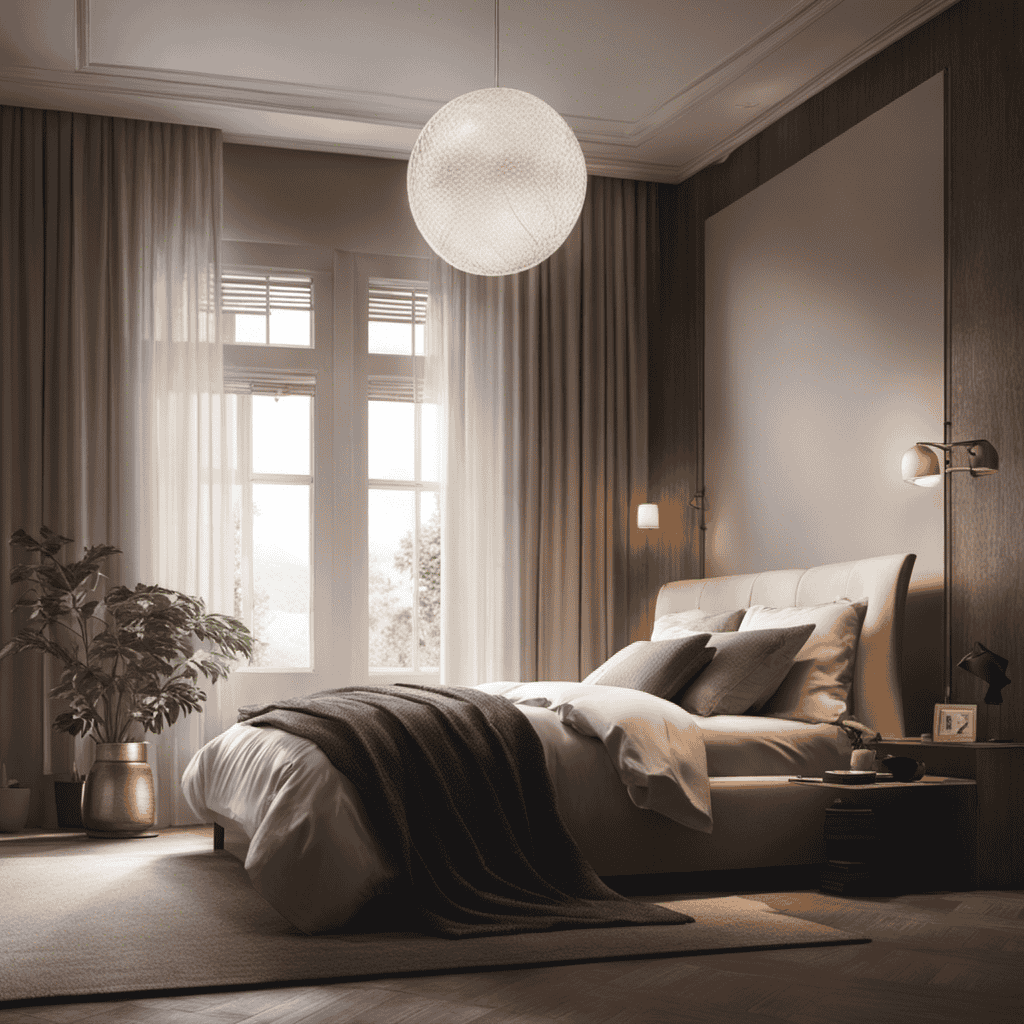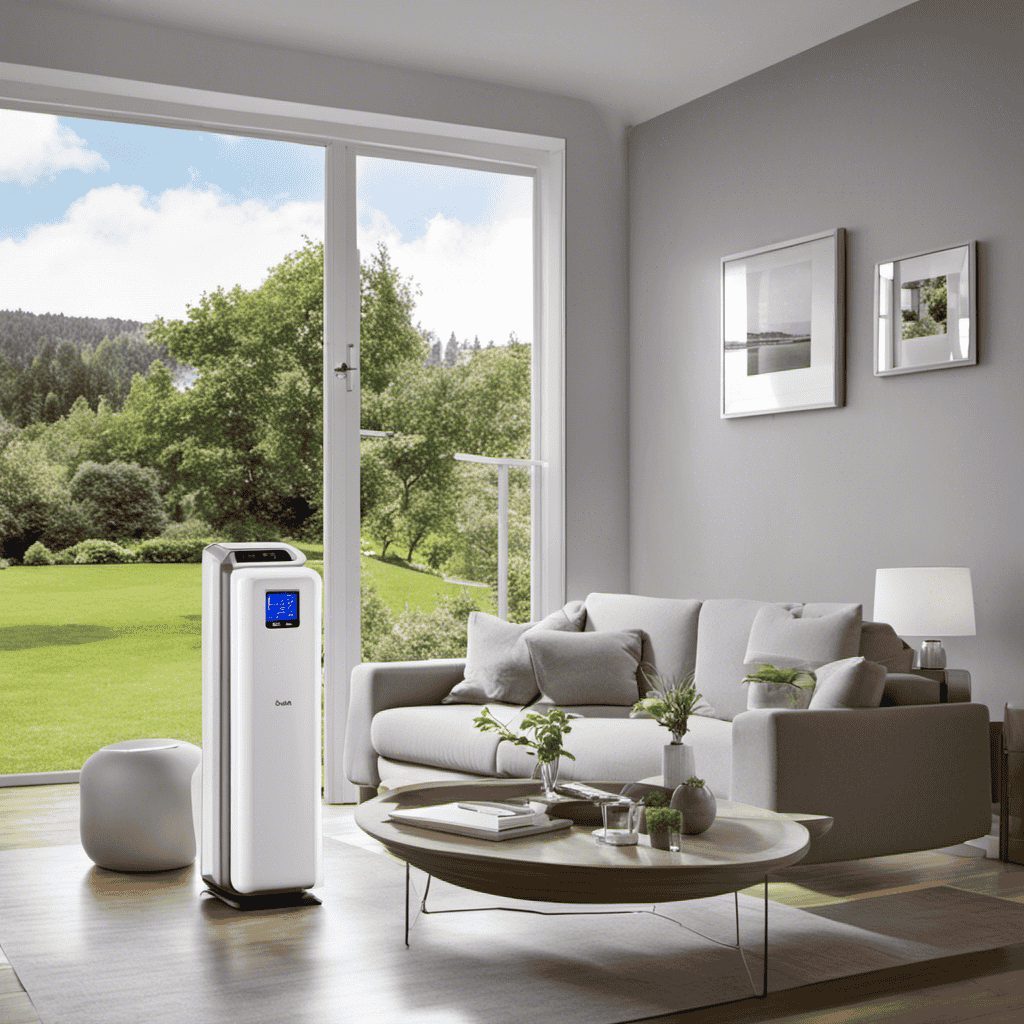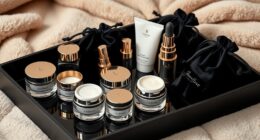As a person who prioritizes getting a good night’s rest, I wasn’t aware of the potential risks of having an air purifier next to my bed. Surprisingly, this innocent-looking device may be harming my health.
In this article, we will explore the health risks associated with air purifiers, including their impact on sleep quality and potential negative effects on breathing. Join me as we delve into the evidence and discover why it might be best to reconsider our sleeping arrangements.
Key Takeaways
- Sleeping with an air purifier next to your head can pose health risks, including the circulation of allergens and the potential for respiratory problems.
- Placing the air purifier at a distance from your head and ensuring proper ventilation can minimize these risks.
- Some types of air purifiers can irritate the respiratory system and may worsen symptoms such as coughing, wheezing, and shortness of breath.
- Individuals with pre-existing respiratory conditions may be more susceptible to breathing discomfort when using an air purifier.
Health Risks Associated With Air Purifiers
There’s a risk of health issues when you sleep with an air purifier next to your head.
While air purifiers are designed to improve air quality and reduce allergens, sleeping with one right next to your head can have negative consequences.
One potential impact is on allergies. Air purifiers can circulate allergens in the air, which can worsen symptoms for individuals with allergies.
Additionally, the noise produced by the purifier can disrupt sleep, leading to fatigue and decreased overall well-being.
Long-term health effects are another concern. Continuous exposure to high levels of ozone produced by some air purifiers can irritate the lungs and cause respiratory problems.
It is advisable to place the purifier at a distance from your head and ensure proper ventilation in the room to minimize the risks associated with sleeping next to an air purifier.
Impact on Sleep Quality
To improve the quality of your sleep, consider placing the air purifier away from your bedside. While air purifiers can be beneficial for allergies and overall air quality, having one too close to your head can actually have a negative impact on your sleep patterns.
Here are a few reasons why:
-
Noise: Air purifiers can produce a constant humming or white noise, which can be disruptive to your sleep.
-
Light: Many air purifiers have indicator lights or displays that can emit bright light, disrupting your sleep environment.
-
Dryness: Some air purifiers can remove moisture from the air, leading to dryness in your bedroom. This can cause discomfort and disrupt your sleep.
-
Allergies: While air purifiers can help with allergies during the day, having one too close to your head at night can actually worsen symptoms for some people.
Potential Negative Effects on Breathing
When considering the potential negative effects of air purifiers on breathing, it is important to examine their impact on respiratory health.
Research has shown that certain types of air purifiers can irritate the respiratory system, causing symptoms such as coughing, wheezing, and shortness of breath.
Additionally, individuals with pre-existing respiratory conditions, such as asthma or allergies, may be more susceptible to experiencing breathing discomfort when using an air purifier.
Air Purifier’s Respiratory Impact
Breathing in the emissions from an air purifier can potentially affect your respiratory system. Air purifiers are often praised for their ability to reduce air pollution and improve respiratory health, but it’s important to understand the potential impact they can have on your well-being. Here are four key points to consider:
-
Ozone emissions: Some air purifiers release ozone as a byproduct, which can irritate the respiratory system and cause symptoms like coughing, wheezing, and shortness of breath.
-
Chemicals from filters: Air purifiers that use activated carbon filters may release volatile organic compounds (VOCs) into the air. These chemicals can trigger respiratory allergies or asthma symptoms.
-
Over-reliance on purifiers: Relying solely on air purifiers to improve indoor air quality may overlook other important measures, such as proper ventilation and reducing pollution sources. It’s crucial to address the root causes of air pollution rather than relying solely on purifiers.
-
Personal sensitivity: Individuals with pre-existing respiratory conditions or sensitivities may experience heightened symptoms when exposed to air purifier emissions. It’s important to consider your own sensitivity and consult with a healthcare professional if needed.
Considering these factors, it is crucial to weigh the potential benefits of air purifiers against their respiratory impact. Now, let’s delve into the concerns surrounding breathing discomfort.
Breathing Discomfort Concerns
Excessive exposure to air purifier emissions can potentially lead to discomfort in breathing. When it comes to our respiratory health, it’s important to be mindful of the air we breathe.
While air purifiers can effectively remove pollutants from the air, prolonged exposure to their emissions can cause respiratory issues. To alleviate breathing discomfort, it’s crucial to adopt proper breathing techniques. Deep breathing exercises can help expand lung capacity and promote better airflow.
Additionally, regularly monitoring air quality is essential in identifying potential sources of discomfort. Various air quality measurement technologies are available, such as particulate matter sensors and carbon dioxide detectors.
Noise and Disturbance During Sleep
If you sleep with an air purifier next to your head, it might disturb your sleep due to the noise it produces. The constant humming and whirring can be quite distracting, making it difficult to fall asleep or stay asleep throughout the night.
Here are four reasons why you should consider placing your air purifier away from your sleeping area:
-
Noise: Air purifiers can emit a considerable amount of noise, especially if they have powerful fans. This noise can disrupt your sleep and prevent you from getting the restful sleep you need.
-
Sleeping position: Having an air purifier next to your head can limit your sleeping position options. It can be uncomfortable to sleep in certain positions if you have a bulky device right next to you.
-
Air quality sensors: Many air purifiers have built-in sensors to detect the air quality in the room. Placing the device away from your head allows it to accurately measure the air quality without being affected by your breathing or body heat.
-
Peaceful sleep environment: By keeping your air purifier at a distance from your sleeping area, you can create a peaceful sleep environment that promotes relaxation and restful sleep.
Electromagnetic Radiation Concerns
Placing your air purifier away from your sleeping area can alleviate concerns about electromagnetic radiation. Electromagnetic radiation exposure from electronic devices has been a topic of concern in recent years, with individuals worrying about potential long-term health effects. While the evidence regarding the health impacts of electromagnetic radiation is still inconclusive, it is always wise to take precautions.
By keeping your air purifier at a distance from your bed, you can reduce your exposure to any potential radiation emitted by the device. This is particularly important for individuals who are more sensitive to electromagnetic radiation or have pre-existing health conditions. It is also advisable to choose air purifiers that have been tested and certified for low electromagnetic radiation emissions.
Is it Safe to Use an Air Purifier While Sleeping?
Using an air purifier while sleeping can provide many benefits of air purifiers, such as improving air quality and reducing allergens. However, it’s important to use the purifier safely by following the manufacturer’s instructions and ensuring proper ventilation in the bedroom.
Alternatives to Sleeping With an Air Purifier Nearby
I’ve researched alternative options for sleeping with an air purifier nearby, and I’ve found some interesting methods to improve the air quality in your bedroom.
First, there are healthier breathing options. You can use a HEPA filter on your HVAC system or buy an air purifying plant.
Secondly, if you want a noise-free sleeping environment, you can try using a white noise machine or a fan to block out unwanted sounds.
Lastly, you can explore natural air purification methods. Open windows to let in fresh air, use essential oils, or invest in an air purifying salt lamp.
These are all great alternatives to sleeping with an air purifier nearby.
Healthier Breathing Options
Using a humidifier instead of an air purifier can provide healthier breathing options. When it comes to clean air and improving air quality, a humidifier can be a great alternative. Here are four reasons why:
-
Humidifiers add moisture to the air, which can help alleviate dryness in your throat and nasal passages, making it easier to breathe.
-
By moisturizing the air, humidifiers can help reduce the presence of airborne allergens such as dust mites and pollen, improving overall air quality.
-
Humidifiers can also help relieve symptoms of respiratory conditions like asthma and allergies, allowing for easier breathing and a more restful sleep.
-
Unlike air purifiers, humidifiers do not rely on filters, making them a cost-effective and low-maintenance option for improving air quality.
Noise-Free Sleeping Alternatives
If you’re looking for a peaceful night’s rest, consider exploring noise-free sleeping alternatives. A quiet environment is crucial for quality sleep, as noise can disrupt our sleep patterns and make it difficult to fall asleep or stay asleep.
To create a noise-free sleep environment, you can try using sound machines or white noise devices. These devices produce a steady and soothing sound that can mask other noises and help you relax.
Another option to consider is using herbal sleep aids. Certain herbs, such as chamomile, lavender, and valerian root, have been used for centuries to promote relaxation and improve sleep quality. These herbal remedies can be found in the form of teas, supplements, or essential oils, and can be a natural and effective way to enhance your sleep experience.
Natural Air Purification Methods
One option to consider for improving the air quality in your home is using houseplants. Indoor plants not only add beauty to your living space but also have natural air purification abilities.
Here are four benefits of indoor plants as natural air purifiers:
-
They remove harmful toxins: Indoor plants can effectively remove pollutants such as formaldehyde, benzene, and trichloroethylene from the air, which are commonly found in household items and cleaning products.
-
They increase oxygen levels: Plants absorb carbon dioxide and release oxygen through photosynthesis, helping to increase the oxygen levels in your home.
-
They humidify the air: Plants release moisture through a process called transpiration, which helps to increase the humidity in dry indoor environments.
-
They reduce stress: Studies have shown that being around plants can reduce stress levels and improve overall well-being.
Conclusion
In conclusion, it’s clear that caution should be exercised when it comes to sleeping next to an air purifier due to potential health risks. While these devices may seem beneficial for cleaner air, they can actually negatively impact our sleep quality. Factors such as breathing issues, disruptive noise, and concerns about electromagnetic radiation can all disrupt our peaceful slumber. Instead of risking our well-being, it’s advisable to explore alternative methods for ensuring a restful night’s sleep. Sweet dreams await, free from the unwanted side effects of an air purifier by our side.










